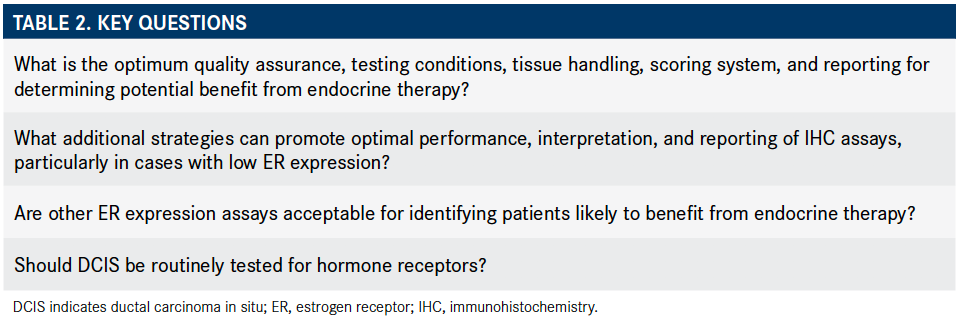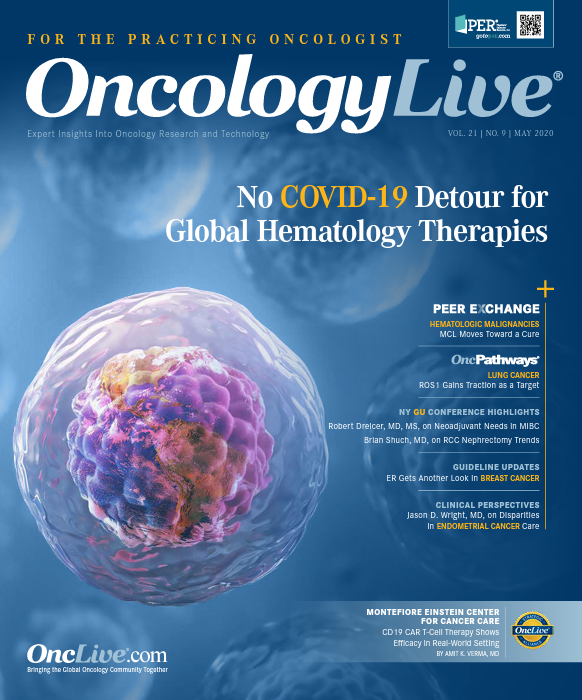Publication
Article
Breast Cancer Guidelines Carve Out Category for Low ER Expression
Author(s):
The American Society of Clinical Oncology and College of American Pathologists have further refined their recommendations for estrogen receptor and progesterone receptor testing protocols in patients with breast cancer.
W. Fraser Symmans, MD, a professor and director of research operations in the Department of Pathology at The University of Texas MD Anderson Cancer Center

W. Fraser Symmans, MD
The American Society of Clinical Oncology (ASCO) and College of American Pathologists (CAP) have further refined their recommendations for estrogen receptor (ER) and progesterone receptor (PgR) testing protocols in patients with breast cancer. The latest update offers guidance for interpreting a new reporting category— ER-low—positive cancers, which are defined as breast cancer samples with 1% to 10% of tumor nuclei staining positive for ER (Table 1).1
How to clinically approach patients with this disease state was 1 of the questions most commonly posed during an open comment period, according to the guideline. Investigators reviewed clinical questions covering areas of diagnostic accuracy as well as methods used to identify patients for endocrine therapy in the first update to the guideline since its initial publication in 2010.1
“The ASCO/CAP guideline has done a terrific job over the past decade of improving the biggest problems that we were previously facing with the quality and reliability of [hormone receptor] testing in breast cancer around the world,” coauthor W. Fraser Symmans, MD, said in an interview with OncologyLive®. “By focusing on the way tissues are processed and the way staining is [performed] and results are interpreted, they’ve standardized this practice nationally and globally,” added Symmans, professor and director of research operations in the Department of Pathology, Division of Pathology/Lab Medicine at The University of Texas MD Anderson Cancer Center in Houston.
The widespread uncertainty about the best practices for addressing breast cancer with low ER expression, coupled with the limited data available on the advantage of endocrine therapy in this patient population, prompted ASCO and CAP to propose care protocols for this subset of patients.
In the guideline update, authors continue to uphold immunohistochemistry (IHC) as the sole standard for identifying patients likely to benefit from endocrine therapy. Whereas breast cancer tissue samples considered ER-positive (1% to 100% of tumor nuclei are positive for ER) are associated with benefit from the use of endocrine therapy, the authors acknowledge that the suitability of the treatment is much more nebulous for low ER-positive cases, which represent about 2% to 3% of ER-positive cases.1
The “controversy” associated with the application of endocrine therapy in the instance of a low ER-positive test result is largely due to the lack of data definitively confirming treatment benefit, according to lead author, Kimberly Allison, MD.2 Part of the ambiguity is due to conflicting data. Although some data currently suggest possible benefit, others suggest that invasive low ER-positive disease is not only heterogeneous in behavior and biology but also has gene expression profiles more similar to ER-negative cancers (<1% or 0% of immunoreactive tumor cell nuclei) than positive cancers.1
However, ASCO and CAP maintain that patients with low ER-positive readouts should nevertheless be considered for endocrine therapy. “The data that we looked at helped affirm that this group probably does benefit from endocrine therapy and probably should be considered positive,” said Allison, director of Breast Pathology at the Stanford University Medical Center in Palo Alto, California.2
The guideline recommends that clinicians discuss the pros and cons of the therapeutic approach with patients, as well as the limited data to conclusively support its use in this population. Treatment decisions should then be made on a case-by-case basis.
In addition to defining the ranges of expression for classification regarding low ER-positive, ER-positive, and ER-negative samples, the guideline also addresses samples that are deemed uninterpretable for ER or PgR. A sample qualifies as uninterpretable if the pathologist determines it to be inadequate, if external and internal controls—if present—do not stain appropriately, or if preanalytical variables interfere with the accuracy of the IHC assay.1
Of note, the same overall interpretation principles apply for PgR testing. For example, samples with 1% to 100% of tumor nuclei are considered positive for PgR and samples, with less than 1% or 0% are negative for PgR. The reporting practices described in the update “are only recommended for ER testing,” the authors write.1
Quality Assurance
The ASCO/CAP update to the ER and PgR testing guideline centers on 4 key questions (Table 2), the first of which is, “What is the optimum quality assurance, testing conditions, tissue handling, scoring system, and reporting for determining potential benefit from endocrine therapy?”1
Of note, there was no change to the ASCO/ CAP recommendations to ensure that optimal testing conditions are in place prior to evaluation by IHC. The expert panel maintains that large, core biopsies of the tumor that represent its grade and type are preferred. If possible, multiple tissue samples should be submitted and should reflect normal and malignant cells, according to Symmans.
“It is best practice to have some of the normal breast structures represented in the slide that is selected for IHC staining because it’s a perfect internal positive control for both ER and PgR,” Symmans said. “Normal tissue should stain in a very characteristic way, indicating that everything went well with the test. If it doesn’t, it’s a clear sign that there is either a preanalytical or analytical problem.”
Table 1. Definitions of ER and PgR Sample Status1 (Click to Enlarge)

The status of internal controls should be reported for cases with 0% to 10% staining, the authors state. If a case for which there are no internal controls present returns this result and has positive external controls, another specimen that does contain internal controls may be necessary to confirm ER status.
The guideline notes that directives for the best internal validation procedures for IHC assays have been deferred to CAP’s forthcoming guideline update of the Principles of Analytic Validation of IHC Assays. At present, the panel advises clinicians to perform an initial test validation before reporting clinical samples and that “previously recommended principles [continue to] apply.”1
Optimal internal quality assurance entails ongoing quality control and equipment maintenance. The guideline states that both initial and ongoing training and competency evaluations of laboratory personnel need also to continue without interruption. Standard operating protocols should be upheld and assays reassessed on a semiannual basis at a minimum. Revalidation is necessary at any time that there is a “significant change” to the test system, the panelists stated.1
Panelists also strongly supported that laboratories conducting ER and PgR testing should participate in external proficiency testing or alternative performance assessment as required by their accrediting organization. There was moderate support for biannual onsite inspection and annual self-inspection.
Compliance with the quality assurance protocols delineated in the ASCO/ CAP guideline has, over time, improved ER and PgR testing. Hormone receptor testing, in particular ER testing, was 1 of the first predictive markers in pathology in 2010, Allison said.2
“It was really important to get standards set. There was a lot of variability at that time in what labs were using as a positive result for ER testing. There was essentially no proficiency testing for labs, no way to know if your lab was giving similar results as other labs. Since then, there’s been dramatic improvements in monitoring the performance and reducing interlab variability in ER testing,” she added.2
Tissue Handling
Regarding other measures that can be taken to optimize the testing process, the ASCO/ CAP panel strongly recommends that the time from tissue acquisition to fixation should be as short as possible. Samples should be sliced at 5-mm intervals after the margins have been designated. Then, the tissue should be fixed in a sufficient volume of neutral buffered formalin (NBF) to promote tissue penetration. Typically, samples procured for ER and PgR testing are fixed in 10% NBF for 6 to 72 hours.
Click to Enlarge

Reporting IHC Results
The second clinical question that the ASCO/ CAP guideline update answers is, “What additional strategies can promote optimal performance, interpretation, and reporting of IHC assays, particularly in cases with low to negative ER expression?”1
Outlining these tactics was a critical focus of the panel, according to Allison. “The vast majority of cancers test strong for ER-positive [disease], so most of our concern [applied to] testing for negative or low-level expression. We wanted to ensure that labs are producing a valid result in the setting of low ER-positive and ER-negative cancers,” Allison said.2
For this reason, when interpreting any ER result, laboratory personnel should include evaluation of the concordance with the histologic findings of each case. Clinicians who observe “highly unusual/ discordant” should consult a pathologist to “attempt to resolve or explain atypical reported findings.”1
Additionally, laboratories should establish and follow a standard operating procedure outlining the steps that the laboratory takes to confirm or adjudicate ER readouts for samples with a stain intensity of at least 10% of cells. These measures can help a laboratory ensure that the IHC result is both accurate and reproducible, Allison said.2
Ductal Carcinoma In Situ Testing
The ASCO/CAP panel issues a moderately strong recommendation for ER testing for newly diagnosed, noninvasive cases of ductal carcinoma in situ to assess the potential benefit of adjuvant endocrine therapy that may reduce the risk of subsequent breast cancer. PgR testing is considered optional for this patient population because there are currently no data that support the prognostic or predictive value of PgR testing in ductal carcinoma in situ independent of ER.1
Each year, more than 1 million women globally are diagnosed with primary breast cancer and undergo ER and PgR testing. Accurate assessment of ER and PgR status, which can guide treatment decisions for women with breast cancer, is critical, particularly as the incidence of ER-positive breast cancer rises. Analyses of contemporary patient populations have shown that ER-positive disease accounts for 79% to 84% of breast cancers, with higher ER-positive rates observed among postmenopausal subpopulations. The large proportion of breast malignancies that test positive for ER render uniform, sustained instruction imperative to ensure validity and proper use of IHC assays in this patient population.1
“With ER testing nationally and globally, we find ourselves in a much better place than we were, and we will adapt to the continuous evolution of improved methods,” Symmans said.
References
- Allison KH, Hammond MEH, Dowsett M, et al. Estrogen and progesterone receptor testing in breast cancer: ASCO/CAP guideline update. Published online January 13, 2020. J Clin Oncol. doi:10.1200/JCO.19.02309.
- Estrogen and progesterone receptor testing in breast cancer guideline update. American Society of Clinical Oncology guidelines. Published January 13, 2020. Accessed January 31, 2020. bit.ly/2Vs7fF2
A tumor sample that originates from a remote location should be bisected, fixed in NBF, and sent to the evaluating laboratory. The clinician would need to note the cold ischemia time, fixative type, and the time of the sample’s placement in NBF. Of note, the panel recommends against use of unstained slides that were cut more than 6 weeks before the tissue analysis.1
Although staining noncancerous tissue does not yield answers about the ER or PgR status of the sample, it validates the accuracy of the IHC assay. However, it is not always possible to confirm the veracity of the stain this way, Symmans said. For example, normal breast tissue will likely not be available in the case of metastatic disease that has recurred.










